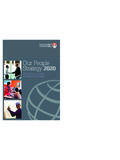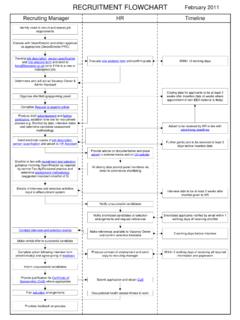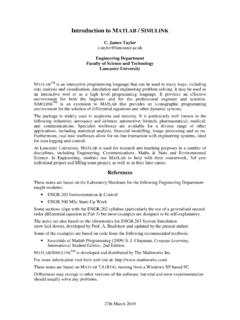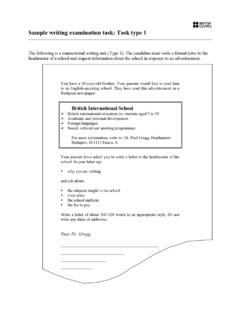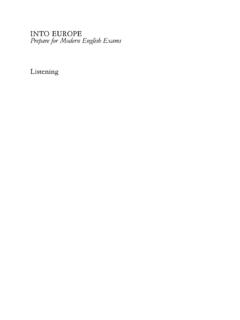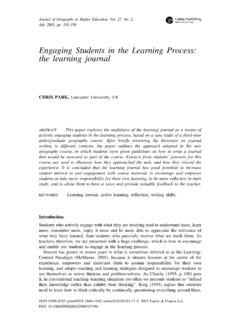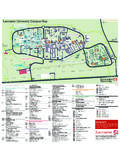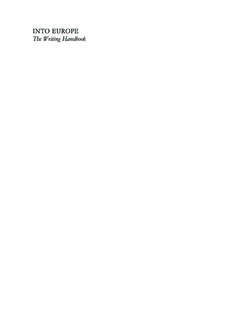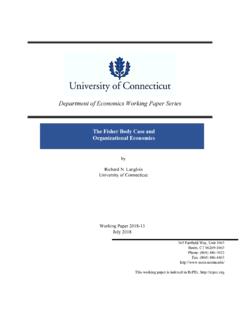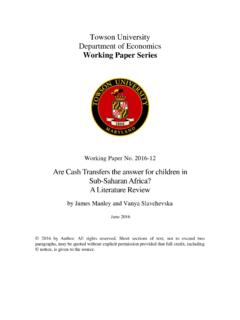Transcription of Economics Working Paper Series - lancaster.ac.uk
1 Economics Working Paper Series 2015/028 International trade and the division of labour Kwok Tong Soo The Department of Economics Lancaster University Management School Lancaster LA1 4YX UK Authors All rights reserved. Short sections of text, not to exceed two paragraphs, may be quoted without explicit permission, provided that full acknowledgement is given. LUMS home page: 1 International trade and the division of labour Kwok Tong Soo* Lancaster University December 2015 Abstract This Paper develops a model of international trade based on the division of labour under perfect competition. International trade, by eliminating the duplication of coordination costs, leads to a greater variety of intermediate goods, each produced at a larger scale than in autarky.
2 The greater variety of intermediate inputs implies greater division of labour and hence gains from trade. Similarly to models of international trade under imperfect competition, the volume of trade depends on the relative sizes of the trading partners. Extending the model to two factors of production yields the additional result that if the two countries are sufficiently similar in their relative endowments, then both factors of production can experience gains from trade. JEL Classification: F11, F15. Keywords: Division of labour; intermediate goods trade; trade liberalisation.
3 * Department of Economics , Lancaster University Management School, Lancaster LA1 4YX, United Kingdom. Tel: +44(0)1524 594418. Email: 2 1 Introduction I always say there are two and a half theories of trade . Paul Krugman to Peter Neary, as quoted in Neary (2010). There are three main approaches to theoretical modelling of international trade: the approach based on comparative advantage and perfect competition from Ricardo to Heckscher and Ohlin, the approach based on monopolistic competition as in Krugman (1979, 1980), and the approach based on oligopoly as initially developed by Brander (1981)1.
4 This Paper develops a new model of international trade which takes a different approach to the preceding literature, by focussing on the division of labour as the reason for international trade. The role of the division of labour in raising per capita incomes has been recognised since at least Adam Smith (1776)2. The model we develop is based on trade in intermediate inputs, which constitutes over half of total goods trade, as documented by Miroudot et al (2009) and Sturgeon and Memedovic (2010), and shares features of both the comparative advantage and monopolistic competition approaches.
5 From the comparative advantage literature, it uses a perfectly competitive market structure; from the monopolistic competition literature, countries are ex ante identical to each other, so there is no comparative advantage reason for international trade. In our model, the division of labour is limited by both the extent of the market, and by coordination costs. International trade eliminates the duplication of coordination costs across countries, which encourages greater division of labour, and hence higher levels of output and welfare. Thus, similarly to models of trade based on monopolistic competition, we endogenise the number of varieties of intermediate goods produced; however, this is done under perfectly competitive markets.
6 Because countries are assumed to have identical technologies in producing intermediate goods and there is no way of identifying individual intermediate goods, the direction of trade is indeterminate; however, the volume of trade is determinate, and depends on the relative sizes of the trading partners. Having established the main features of the model with one final good and one factor of production, we then proceed to extend the model to two final goods and two factors of production, similarly to Krugman s (1981) extension of his earlier 1 The oligopolistic approach is what Neary (2010) refers to as the half theory of trade, since it is not as widely used as the other two approaches, despite the efforts of Neary (2009).
7 2 In fact, the literature on international trade under monopolistic competition may be viewed as one approach to analysing the implications of the international division of labour. The model presented in this Paper presents a different approach to this issue. 3 (Krugman 1980) model. This enables us to consider the distributional implications of the model. With more than one factor of production, there are now two sources of the gains from trade: the division of labour as in the one factor model, and relative endowment differences as in the Heckscher-Ohlin model. As a result, it is possible, if the two countries are not too dissimilar from each other in their relative endowments, that both factors of production gain from trade.
8 This is similar to the result in Krugman (1981) and in contrast to the traditional Heckscher-Ohlin result, where the scarce factor always loses from trade. The role of the division of labour in international trade has been developed especially by Ethier (1979, 1982a). In the earlier Paper , the distinction is not made between external and internal scale economies, while the later Paper is explicit in its use of both internal and external scale economies. Francois (1990a, 1990b) makes use of the production function developed by Edwards and Starr (1987) to develop a model of international trade in which scale economies arise from producer services in a monopolistic competition model.
9 More recently, Chaney and Ossa (2013) open up the black box of the production function in the Krugman (1979) model of monopolistic competition, modelling the production process as a Series of stages produced by teams. Becker and Murphy (1992) develop a closed economy model in which the extent of the division of labour is limited by the cost of coordinating inputs. This is similar to that used by Francois (1990a, 1990b), and is the approach adopted in the present Paper . Because the present Paper makes use of a perfectly competitive framework, it is different from the literature above (apart from Becker and Murphy (1992), who do not consider international trade).
10 Nevertheless, we obtain some results which are qualitatively similar to those of models based on monopolistic competition such as Krugman (1979). Swanson (1999) develops a different model of the division of labour under perfect competition, in which a larger market enables greater specialisation and hence higher skill levels and output per worker via the endogenous development of comparative advantage. More closely related is Soo (2013), who develops a model of international trade based on the division of labour and comparative advantage in a perfectly competitive framework. Unlike Soo (2013), who makes use of comparative advantage to pin down the structure of production, in the present Paper we focus on the cost of coordinating inputs that limits the extent of the division of labour.
